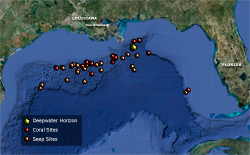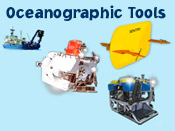 Click to enlarge
Our Mission: December 6-14, 2010
On April 20, 2010, the oil-drilling rig Deepwater Horizon exploded and sank in the Gulf of Mexico. The well it was drilling continued to gush oil for nearly three months, eventually causing one of the worst oil spills in history. When it was finally stopped, the well had poured millions of gallons of oil into the water.
Dive and Discover’s Expedition 13 will take you beneath the surface of the Gulf to investigate life on the bottom of the ocean and to look for signs of impact by the oil on deep-sea ecosystems. In addition to fouling beaches, threatening wildlife, and shutting down fisheries, scientists are concerned that there could also be damage to the little-known animals and the communities in the deep ocean.
The expedition will feature six dives by the submersible Alvin to carefully document the bottom and to collect samples of animals and sediment. Scientists will also send the autonomous underwater vehicle (AUV) Sentry out on overnight missions to map and photograph the bottom. This expedition follows a cruise with the remotely operated vehicle (ROV) Jason in October, during which many of the same scientists on Expedition 13 discovered dozens of dead and dying corals just seven miles from the Deepwater Horizon well. With Alvin and Sentry working in tandem, this team will revisit that site as well as seek out unexplored places on the ocean floor to learn whether the oil spill did, in fact, affect animals in the deep.
Expedition 13 also marks the last dives with the submersible Alvin before it undergoes a complete overhaul. When Alvin returns to the water in 2012, it will help scientists produce even more eye-opening research in the deep ocean.
FROM DEEPER DISCOVERY


HOT TOPICS
 Alvin Upgrade
Alvin Upgrade
In 2011, Alvin will undergo a major overhaul that will include a larger personnel sphere and new, deeper-diving capabilities.
 AUV Sentry
Sentry AUV Sentry
Sentry is a robotic deep submersible that can map the ocean bottom, take photographs, and make millions of measurements.
 Deep
Sea Biology Deep
Sea Biology
Creatures that
live at these depths have adapted to a way of life in one of the world's most
challenging environments.  Deep-Sea
Corals Deep-Sea
Corals
Absence of light accounts for many differences between deep-sea corals and their better-known peers near the sea surface.  Keeping
the “Big O” Out of Alvin
Alvin Keeping
the “Big O” Out of Alvin
Alvin pilot
BLee Williams explains the dangers of using electricity in
the ocean.  What
Is It Like To Go Down In Alvin? What
Is It Like To Go Down In Alvin?
So you
want to dive to the bottom of the ocean in a sub? Better
bring your wool hat, because it is cold down there.  Seasickness Seasickness
It’s a fact of life on ships, but nobody talks
about it much. Why should they? It’s not a pretty picture. Yep,
I’m talking about the green scourge,
Neptune’s revenge—seasickness.
Special Life in a Special Place
Animals in the deep ocean are able to survive in some very difficult conditions, including freezing cold and crushing pressure. But perhaps the most remarkable thing about deep-sea animals is their ability to live so far from the life-giving reach of sunlight.
Most animals on Earth rely on the sun and a process called photosynthesis  to provide them with food. Plants use sunlight to convert water and carbon dioxide into materials that serve as food for animals, which in turn become food for other animals further up the food chain. Even in the deep sea, beyond the reach of sunlight, many animals maintain a connection to the surface and to photosynthesis by feeding on bits of dead plants and animals that drift down through the water. to provide them with food. Plants use sunlight to convert water and carbon dioxide into materials that serve as food for animals, which in turn become food for other animals further up the food chain. Even in the deep sea, beyond the reach of sunlight, many animals maintain a connection to the surface and to photosynthesis by feeding on bits of dead plants and animals that drift down through the water.
A few microbes on the seafloor, however, have the ability to survive independent of photosynthesis by obtaining energy from chemicals flowing out of the seabed. This process is called chemosynthesis  and it happens in the Gulf in areas known as cold seeps and it happens in the Gulf in areas known as cold seeps  . Some of the chemicals these microbes use to generate energy and convert inorganic carbon to organic carbon molecules include methane (natural gas) and sulfides, a group of compounds that includes the rotten-egg-smelling hydrogen sulfide. A few microbes have also developed special relationships with other animals in which both organisms obtain some benefit from the other such as food or shelter. This is known as symbiosis . Some of the chemicals these microbes use to generate energy and convert inorganic carbon to organic carbon molecules include methane (natural gas) and sulfides, a group of compounds that includes the rotten-egg-smelling hydrogen sulfide. A few microbes have also developed special relationships with other animals in which both organisms obtain some benefit from the other such as food or shelter. This is known as symbiosis  and is found in tubeworms and some mussels. and is found in tubeworms and some mussels.
Objectives
One of the main objectives of Expedition 13 is to investigate whether the oil or chemicals known as dispersants  that were used to break up oil slicks have affected life at the bottom of the Gulf of Mexico. Scientists will survey the bottom remotely (using Sentry) and directly with their own eyes (in Alvin). They will also collect samples of sediments, corals and other animals to analyze later in the lab. that were used to break up oil slicks have affected life at the bottom of the Gulf of Mexico. Scientists will survey the bottom remotely (using Sentry) and directly with their own eyes (in Alvin). They will also collect samples of sediments, corals and other animals to analyze later in the lab.
Expedition 13 will also examine how different animals obtain their food in the deep, how different food sources influence the makeup of deep-sea communities, and how food may have changed over the past year. To do this, researchers will retrieve two instruments known as sediment traps  that were placed on the seafloor in June to compliment another set deployed in 2009. These traps provide information about the source of energy for deep-ocean ecosystems—whether it comes from photosynthesis in the sunlit upper ocean or chemosynthesis at cold seeps—that will help scientists better understand any impacts the oil might have had on animals that live far below the surface. that were placed on the seafloor in June to compliment another set deployed in 2009. These traps provide information about the source of energy for deep-ocean ecosystems—whether it comes from photosynthesis in the sunlit upper ocean or chemosynthesis at cold seeps—that will help scientists better understand any impacts the oil might have had on animals that live far below the surface.
So hop on board with the scientists of Expedition 13 and learn more about the Gulf of Mexico and the deep-sea. You will be surprised by what you find—from the creatures that live there, to the ways they survive, to the instruments that search the deep. From day one, you are sure to get an eyeful as we dive into this highly studied, but little-known world of the Gulf of Mexico and discover a special part of the planet we call home.
[Back
to top]
|


 AUV Sentry
AUV Sentry 



